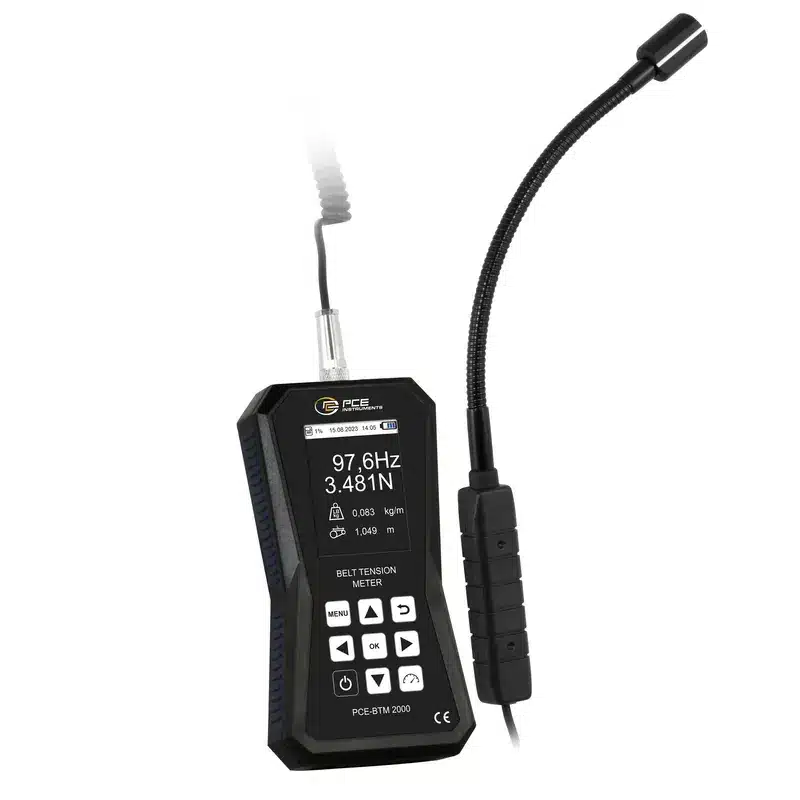Belt Tension Meter
Are you in search of a reliable Belt Tension Meter or Belt Tension Gauge supplier in Dhanbad, Jharkhand, India? Look no further! We are your trusted source for high-quality belt tension meters. Our inventory includes a wide range of options, from V belt tension meters to digital belt tension meters. With our precise belt tension measuring tools and devices, you can accurately assess and maintain the tension of your belts, ensuring optimal performance and longevity. We offer competitive prices on our belt tension meters and guarantee their durability and accuracy. Don’t let belt issues disrupt your operations. Choose our belt tension meters and experience reliable and efficient belt maintenance. Contact us today to inquire about our belt tension meter prices and find the perfect solution for your needs.
The belt tension meter is an optical measuring instrument for determining the belt tension force. This belt tension meter consists of a display unit and a sensor on a gooseneck cable. The belt tension meter measures the tension of the belt in a stationary state.
- Measures the oscillation frequency of the belt
- Measuring range: 10 … 900 Hz
- Accuracy: ± (1% of rdg. + 4 digits)
- Resolution: <100 Hz: 0.1 Hz >100 Hz: 1 Hz
- Memory for 750 measured values
- Length of gooseneck sensor 25 cm / 9,8 in
The belt tension meter is an optical measuring instrument for determining the belt tension force. This belt tension meter consists of a display unit and a sensor on a gooseneck cable. The belt tension meter measures the tension of the belt in a stationary state.
-
- Measures the oscillation frequency of the belt
- Measuring range: 10 … 900 Hz
- Accuracy: ± (1% of rdg. + 4 digits)
- Resolution: <100 Hz: 0.1 Hz >100 Hz: 1 Hz
- Memory for 750 measured values
- Length of gooseneck sensor 16 cm
Belt Tension Meter: A Comprehensive Guide to Optimal Belt Tensioning
Introduction
In various industries and mechanical applications, the efficiency and longevity of power transmission belts play a vital role. One crucial aspect of ensuring optimal belt performance is maintaining the correct tension. Incorrect tension can lead to excessive wear, slippage, and even catastrophic belt failure. To address this challenge, engineers and maintenance professionals rely on a sophisticated tool known as a belt tension meter. In this article, we will explore the ins and outs of belt tension meters, their applications, and where they are commonly used.
What is a Belt Tension Meter/Gauge?
A belt tension meter, also known as a belt tension gauge or a belt tension tool, is a specialized instrument designed to measure the tension of power transmission belts accurately. This portable device utilizes various technologies, such as sonic, optical, or strain gauge, to determine the tension in a belt. By measuring the deflection or vibration of the belt under a specified force, the tension meter provides precise tension readings, allowing maintenance professionals to adjust the belt tension to the manufacturer’s recommended specifications.
Importance of Proper Belt Tension Gauge
Maintaining the correct tension in power transmission belts is crucial for several reasons. Firstly, under-tensioned belts can lead to slippage, reducing power transmission efficiency and causing a decline in system performance. On the other hand, over-tensioned belts can cause excessive stress on the belt, bearings, and other components, leading to premature wear, increased energy consumption, and even equipment failure. By ensuring optimal belt tension, industries can achieve improved productivity, energy efficiency, and reduced maintenance costs.
Applications of Belt Tension Meters
Belt tension meters find applications across a wide range of industries and mechanical systems. Some of the key areas where belt tension meters are utilized include:
1. Industrial Machinery and Manufacturing
In the realm of industrial machinery and manufacturing, belt-driven systems are pervasive. Conveyor belts, power transmission belts, and timing belts are extensively used to facilitate the movement of materials and power transmission in assembly lines, packaging equipment, and automated machinery. Accurate belt tensioning using a belt tension meter ensures smooth operation, minimizes downtime and prevents unexpected breakdowns.
2. Automotive Industry
In the automotive sector, belt-driven systems are vital for various functions, such as driving the alternator, water pump, power steering, and air conditioning compressor. Automotive technicians use belt tension meters to accurately measure the tension in serpentine belts and timing belts, ensuring proper operation and reducing the risk of belt-related failures that can lead to engine damage.
3. HVAC (Heating, Ventilation, and Air Conditioning)
HVAC systems commonly employ belts for driving fans, blowers, and pumps. By using a belt tension meter, HVAC technicians can optimize belt tension, leading to improved energy efficiency, reduced noise levels, and enhanced system performance.
4. Agriculture and Farming
In the agricultural sector, belts are extensively used in various machinery, including tractors, combines, and hay balers. Proper belt tensioning using a belt tension meter ensures reliable power transmission and minimizes the risk of belt slippage, which can hamper productivity during critical farming operations.
5. Power Generation
Power plants, both conventional and renewable, rely on belts for transmitting power from turbines or engines to generators. Belt tension meters are indispensable tools in power generation facilities, enabling operators to maintain precise belt tension for optimal power transmission efficiency and prevent unplanned outages.
6. Mining and Material Handling
In the mining industry, conveyor belts are essential for transporting bulk materials. Belt tension meters play a crucial role in ensuring proper tensioning of conveyor belts, preventing material spillage, and maximizing productivity in mines and material handling facilities.
How to Use a Belt Tension Meter?
Using a belt tension meter involves the following steps:
-
Identify the belt type: Determine the type of belt being measured, such as V-belt, timing belt, or flat belt.
-
Prepare the belt: Ensure that the belt is clean, free from debris or contaminants, and properly aligned.
-
Position the tension meter: Place the tension meter in the appropriate location on the belt. This may involve pressing the meter against the belt or attaching it to a specific point using a magnetic or mechanical attachment.
-
Apply the specified force: Depending on the type of belt tension meter, apply the recommended force to the belt. This force is typically mentioned in the manufacturer’s instructions and is crucial for obtaining accurate tension readings.
-
Take the tension reading: Follow the instructions provided with the belt tension meter to obtain the tension reading. Some tension meters display readings directly on the device, while others may require connecting to a separate display unit or a smartphone app.
-
Compare with manufacturer’s specifications: Compare the obtained tension reading with the manufacturer’s recommended tension values for the specific belt type and application. Adjust the tension if necessary, following the manufacturer’s guidelines.
Benefits of Using a Belt Tension Meter
Utilizing a belt tension meter offers several advantages, including:
-
Accuracy: Belt tension meters provide precise tension measurements, ensuring that belts are neither under-tensioned nor over-tensioned.
-
Preventive Maintenance: Regularly monitoring and adjusting belt tension using a tension meter helps prevent premature belt failures, reducing downtime and maintenance costs.
-
Energy Efficiency: Optimal belt tension reduces power losses due to slippage, leading to improved energy efficiency and cost savings.
-
Extended Belt Life: Correct tensioning helps maximize the lifespan of belts, saving money on replacement and reducing environmental impact.
-
Enhanced Equipment Performance: Properly tensioned belts minimize vibration, noise, and wear, contributing to smoother operation and improved overall system performance.
Working Principle of a Belt Tension Meter
The working principle of a belt tension meter revolves around measuring the deflection or vibration of a power transmission belt under a specified force. The exact method employed can vary depending on the type of tension meter, but the fundamental concept remains the same: quantifying the tension in the belt.
One common approach is the strain gauge method. In this method, the tension meter consists of a strain gauge sensor that is attached to a flexible beam or arm. When the tension meter is placed against the belt, the force exerted by the belt causes the beam or arm to deflect. The strain gauge measures this deflection, and based on its output, the tension in the belt can be determined.
Another method is the sonic or acoustic method. In this technique, the tension meter emits sound waves or vibrations into the belt. The waves travel through the belt and are detected by a receiver on the other side. The tension of the belt affects the speed at which the waves propagate, and by analyzing the received signals, the tension meter calculates the belt tension.
Optical methods are also used in some belt tension meters. These meters utilize optical sensors to measure the vibration or displacement of the belt caused by the applied force. The sensor captures the movement and converts it into tension readings.
It’s important to note that different belt tension meters may use a combination of these principles or employ additional technologies to provide accurate tension measurements.
Price of Belt Tension Meters in India
The price of belt tension meters in India can vary depending on various factors such as the brand, features, accuracy, and capabilities of the meter. Generally, basic handheld belt tension meters can be found in the range of ₹5,000 to ₹50,000 INR. These models are suitable for most common applications and offer reliable tension measurements.
For more advanced belt tension meters with additional features and capabilities, the price can range from ₹15,000 to ₹2,00,000 INR or more. These high-end models may offer wireless connectivity, data logging, advanced data analysis, and compatibility with software applications.
It’s important to consider the specific requirements of your application and the desired level of accuracy and functionality when selecting a belt tension meter. Additionally, it’s recommended to compare prices from different suppliers and check for warranties, customer support, and after-sales service to ensure a satisfactory purchase experience.
Please note that the mentioned price range is an approximation based on the information available up to September 2021, and prices may vary over time due to factors such as market demand, inflation, and currency fluctuations. It’s always advisable to consult local suppliers or online retailers for the most up-to-date pricing information.
Belt Tension Gauges: Essential Applications and Benefits
Introduction
In the world of engineering and industrial machinery, precision and performance go hand in hand. One crucial aspect that significantly affects the efficiency and longevity of power transmission belts is their tension. To measure and maintain the optimal tension in belts, industry experts rely on an indispensable tool known as the belt tension gauge. In this article, we will delve into the main applications of belt tension gauges and highlight their importance in various sectors. Let’s explore how this device revolutionizes maintenance practices and ensures optimal performance.
1. Understanding Belt Tension Gauge
A belt tension gauge also referred to as a tension meter or tensioner, is a handheld device designed to measure the tension in power transmission belts. It works on the principle of deflection, where the amount of force applied to the belt results in a specific deflection that the gauge accurately measures. With the data obtained, engineers can ascertain whether the belt tension meets the manufacturer’s recommended specifications and make necessary adjustments accordingly.
2. Automotive and Vehicle Maintenance
One of the primary applications of the belt tension gauge lies in the automotive and vehicle maintenance industry. Drive belts play a crucial role in modern vehicles, powering various components such as alternators, air conditioning compressors, and power steering pumps. Ensuring proper tension in these belts is essential for smooth operation and prevents premature wear. Belt tension gauges enable mechanics to maintain optimal belt tension, thus extending the lifespan of components and reducing the risk of breakdowns.
“Belt tension gauge for automotive maintenance”
1. Industrial Machinery
In industrial settings, belts serve as a fundamental component for transmitting power between different parts of machinery. Whether it’s in manufacturing plants, conveyor systems, or heavy machinery, belt tension directly affects efficiency and overall productivity. Utilizing belt tension gauges empowers operators to fine-tune belt tension accurately, preventing slip and excessive wear that could lead to costly downtimes
“Belt tension gauge for industrial machinery”
2. HVAC Systems
Heating, ventilation, and air conditioning (HVAC) systems rely on belts for efficient operation. A properly tensioned belt ensures that the HVAC components, such as fans and blowers, run smoothly and at their optimal performance levels. Belt tension gauges help HVAC technicians maintain the right tension, which not only improves energy efficiency but also reduces noise and enhances system longevity.
“Belt tension gauge for HVAC maintenance”
3. Agriculture and Farming Equipment
In the agricultural sector, power transmission belts are vital for driving various farm equipment, such as combines, tractors, and harvesters. Maintaining the correct tension in these belts is critical for peak performance during crucial planting and harvesting seasons. Belt tension gauges allow farmers to ensure their equipment operates at maximum efficiency, leading to increased productivity and reduced downtime.
“Belt tension gauge for farming equipment”
Conclusion
The belt tension gauge emerges as a game-changer in multiple industries, revolutionizing maintenance practices and enhancing the performance of power transmission belts. Its diverse applications in automotive, industrial, HVAC, and agricultural sectors underscore its indispensable role in ensuring optimal tension and driving peak machinery performance. By accurately measuring belt tension, engineers and technicians can proactively prevent issues, prolong equipment life, and improve overall productivity. Embracing this powerful tool is the key to staying ahead in the competitive world of precision engineering and industrial maintenance.



